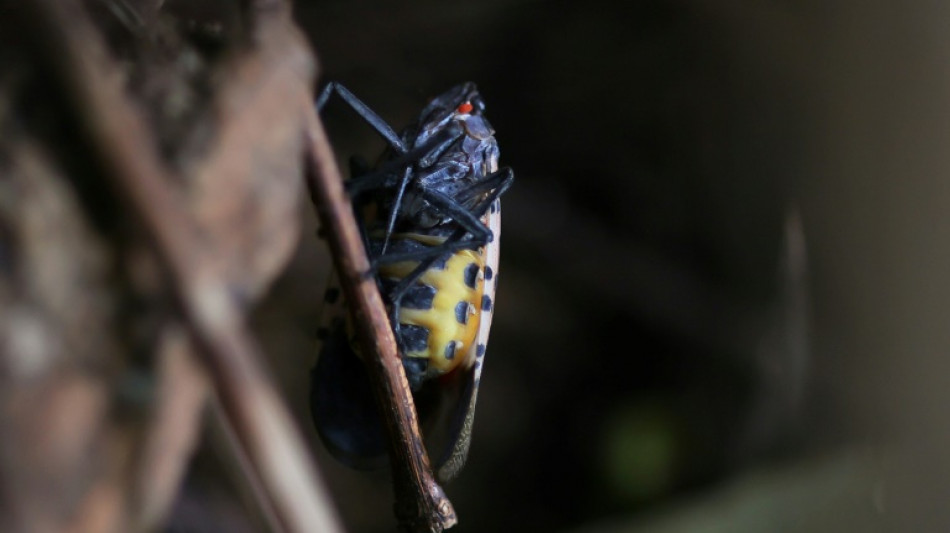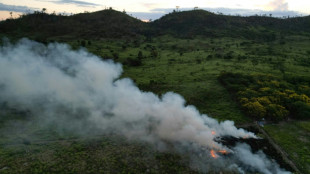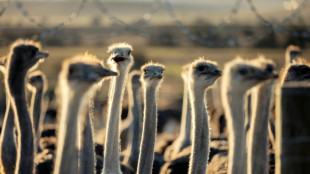
-
 Scandic Trust Group strengthens sales network with First Idea Consultant
Scandic Trust Group strengthens sales network with First Idea Consultant
-
Chile presidential hopeful vows to expel 'criminal' migrants to El Salvador

-
 Trump event paused in Oval Office when guest faints
Trump event paused in Oval Office when guest faints
-
NFL Colts add Sauce to recipe while Patriots confront Baker

-
 Home owned by Miami Heat coach Spoelstra damaged by fire
Home owned by Miami Heat coach Spoelstra damaged by fire
-
Tesla shareholders approve Musk's $1 trillion pay package

-
 World leaders launch fund to save forests, get first $5 bn
World leaders launch fund to save forests, get first $5 bn
-
Villa edge Maccabi Tel Aviv in fraught Europa League match

-
 Protests as Villa beat Maccabi Tel Aviv under tight security
Protests as Villa beat Maccabi Tel Aviv under tight security
-
US Supreme Court backs Trump admin's passport gender policy

-
 Japan boss Jones backs Farrell to revive Ireland's fortunes
Japan boss Jones backs Farrell to revive Ireland's fortunes
-
MLB Padres name former reliever Stammen new manager

-
 'Grand Theft Auto VI' video game delayed again until Nov. 2026
'Grand Theft Auto VI' video game delayed again until Nov. 2026
-
Martino returns as head coach of MLS Atlanta United

-
 Hamilton dismisses Ferrari exit claims
Hamilton dismisses Ferrari exit claims
-
Musetti keeps ATP Finals hopes alive, joins Djokovic in Athens semis

-
 England boss Borthwick wants 'brilliant' Marcus Smith to shine against Fiji
England boss Borthwick wants 'brilliant' Marcus Smith to shine against Fiji
-
Piastri says he is confident he can recover and win drivers' title

-
 Verstappen admits he may need a bit of 'luck' to haul in rivals in title race
Verstappen admits he may need a bit of 'luck' to haul in rivals in title race
-
Kazakhstan to join Abraham Accords as Trump pushes Mideast peace

-
 'Moral failure': Leaders seek to rally world at Amazon climate talks
'Moral failure': Leaders seek to rally world at Amazon climate talks
-
UN Security Council votes to lift sanctions on Syrian president

-
 Democratic giant, trailblazer and Trump foe Nancy Pelosi to retire
Democratic giant, trailblazer and Trump foe Nancy Pelosi to retire
-
World leaders ditch ties at sweaty climate summit

-
 Dallas Cowboys' Marshawn Kneeland dies at 24
Dallas Cowboys' Marshawn Kneeland dies at 24
-
Rally outside Rockstar against GTA studio's 'union busting'

-
 McLaren boss says would rather lose title than issue team orders
McLaren boss says would rather lose title than issue team orders
-
Sabalenka, top WTA stars urge Slams to revive 'stalled' negotiations

-
 5 killed in Afghan-Pakistan border fire despite peace talks: official
5 killed in Afghan-Pakistan border fire despite peace talks: official
-
Trump unveils deals to lower costs of some weight-loss drugs

-
 Controversial Canadian ostrich cull order will go ahead
Controversial Canadian ostrich cull order will go ahead
-
Mexico's Sheinbaum to boost reporting of sexual abuse after being groped

-
 Zuckerbergs put AI at heart of pledge to cure diseases
Zuckerbergs put AI at heart of pledge to cure diseases
-
Crypto giant Coinbase fined in Ireland for rule breaches

-
 Lawson relieved as he reveals FIA support following Mexican near-miss
Lawson relieved as he reveals FIA support following Mexican near-miss
-
US set for travel chaos as flights cut due to govt shutdown

-
 Sabalenka and Pegula book their spots in WTA Finals last four
Sabalenka and Pegula book their spots in WTA Finals last four
-
'Our brother-in-law': Arab world embraces New York's new mayor

-
 France boss Deschamps would prefer to 'avoid playing' on Paris attacks anniversary
France boss Deschamps would prefer to 'avoid playing' on Paris attacks anniversary
-
Pegula sweeps past Paolini to reach WTA Finals last four

-
 Bolivian ex-president Anez leaves prison after sentence annuled
Bolivian ex-president Anez leaves prison after sentence annuled
-
Stocks slide as investors weigh data, interest rate cuts

-
 UN says 2025 to be among top three warmest years on record
UN says 2025 to be among top three warmest years on record
-
Fleetwood and Lowry lift each other into Abu Dhabi lead

-
 Fleetwod and Lowry lift each other into Abu Dhabi lead
Fleetwod and Lowry lift each other into Abu Dhabi lead
-
New Zealand make changes after Barrett brothers' injuries as Scotland drop Van der Merwe

-
 Dallas Cowboys' Marshawn Kneeland dies at 24: franchise
Dallas Cowboys' Marshawn Kneeland dies at 24: franchise
-
Pegula dispatches Paolini to keep WTA Finals semis bid alive

-
 Dutch giants Ajax sack coach John Heitinga
Dutch giants Ajax sack coach John Heitinga
-
Kirchner on trial in Argentina's 'biggest ever' corruption case


In US, invasive spotted lanternflies are devastating crops
At first glance, the spotted lanternfly looks like an elegant butterfly, speckled with black spots on white wings with a splash of bright red.
But the insect native to parts of Asia (Lycorma delicatula) is attacking plants and trees in the United States, and officials are moving quickly to try to contain its spread.
"The only good spotted lanternfly is a dead one," said Amy Korman, an entomologist at Penn State Extension, a part of the university that provides training and education in everything from farming to food safety to landscaping.
The insect was first detected in the United States in 2014, in Berks County, Pennsylvania. An egg mass was found in a shipment of stone from China, according to experts who have tracked its progress.
The SLF -- as experts call it -- poses no threat to humans or animals, but it has caused hundreds of millions of dollars in damage in the US agricultural sector, even though it has only been found in 14 states.
In 2020, a Penn State study indicated that in Pennsylvania alone, the insect was responsible for $554 million in annual losses, and the disappearance of nearly 5,000 jobs a year.
Despite huge efforts including quarantines, state officials could not contain the insect population.
"The spotted lanternfly is a very good hitchhiker," explained Korman. Despite its spectacular wings, the bug is not known to fly long distances.
"These insects are very sneaky. They spread thanks to us. We are taking them across the country, especially their eggs," the expert added.
Those clusters -- which look like clumpy smears of mud -- end up on tree bark, outdoor equipment such as lawn mowers or grills, and have even "survived some very harsh winters," Korman said.
Once the lanternfly reaches adulthood, it feeds on dozens of crops, ornamental and fruit trees, timber and plants. Once a number of insects feed from the same plant, it dies.
- Grape lover -
Spotted lanternflies have a particular affinity for grape vines. Scientists have observed dozens, even hundreds of them on a single vine.
Just ask Michael Fiore, who owns a winery and distillery in Maryland that was infested with SLFs last year.
"We have lost 1,000 vines," Fiore told AFP.
"The energy has been sucked out -- it's like a vampire," he explained, predicting he will lose half of his harvest this year, and rebuilding will take time.
"2022 was bad, 2023 is just as bad," he lamented.
Fiore is not alone -- winemakers across Pennsylvania and Maryland have suffered, between the loss of vines and lesser output from those that survived the infestation.
The insects also leave a buildup of sticky fluid (known as honeydew) on plants, which creates what the US Department of Agriculture (USDA) calls "sooty mold."
When that mold fully covers a plant's leaves, it prevents photosynthesis -- the process by which plants convert sunlight into chemical energy -- from taking place, and the plant dies.
Several US states have tasked scientists with finding a way to eradicate the SLF -- a true race against the clock, as entomologists predict the pest will reach the US West Coast -- and its storied vineyards -- by 2027-2030.
American orchards would also be affected, and Canada is worried too.
California's wine industry generates $170.5 billion in annual economic activity and employs 1.1 million people, according to the Wine Institute, an advocacy group.
In June, the USDA unveiled a five-year plan to study and combat the SLF phenomenon.
"We don't understand the full picture," said Matthew Travis, the USDA's point man on the crisis. "It's very challenging for us."
"There are so many things we don't know, especially in the population dynamics year after year and their uneven distribution," Travis noted, adding that experts have traveled to Asia to study the insect, but those visits were inconclusive.
"It's been a little difficult because they never saw the same big phenomena as we have here," he said.
Those obstacles have made it difficult to calculate the long-term financial consequences of the SLF's emergence in the United States.
On the grassroots level, residents have organized makeshift patrols to kill the bugs -- because they don't fly far, they are relatively easy to smash, but their relatively large size makes the task rather unappetizing.
In Westchester County, in the northern suburbs of New York City, sniffer dogs are being deployed to find SLF egg masses -- and giant vacuums are being used to suck up older specimens.
Some have gone so far as to poison the sap of the tree of heaven, one of the insect's favorite trees that also comes from Asia.
But the spotted lanternfly does not have a natural predator in North America.
A.AbuSaada--SF-PST



